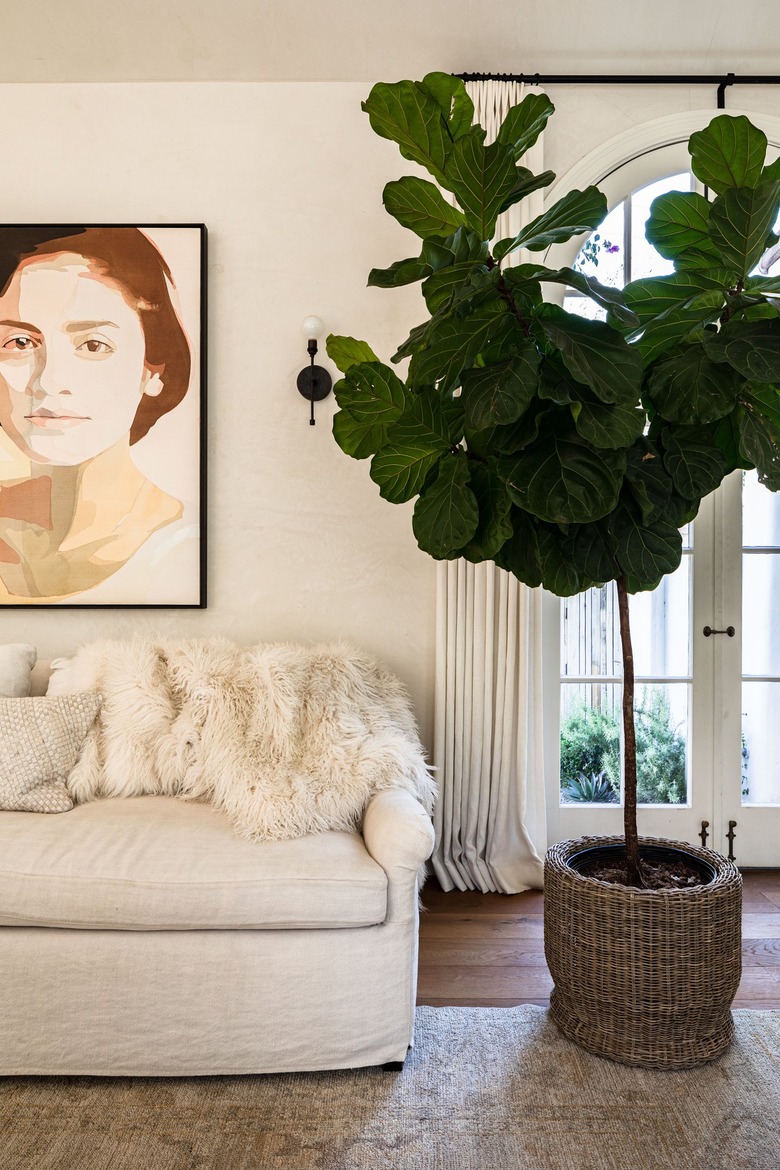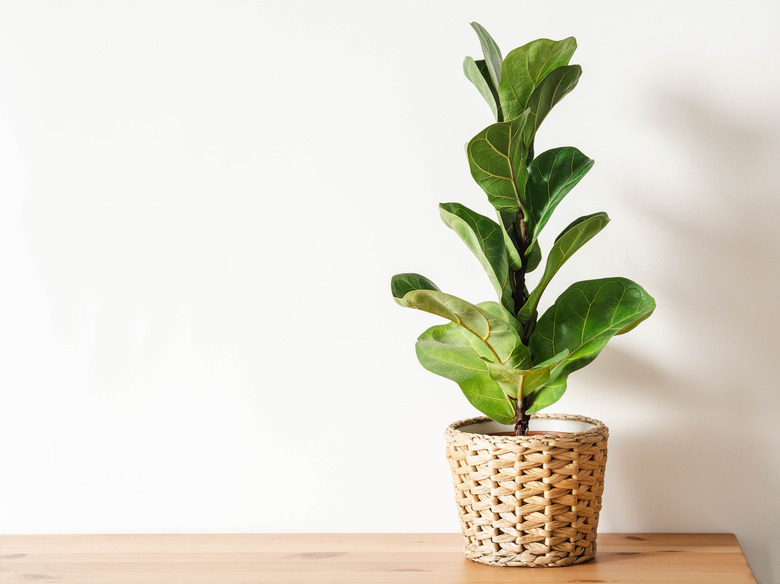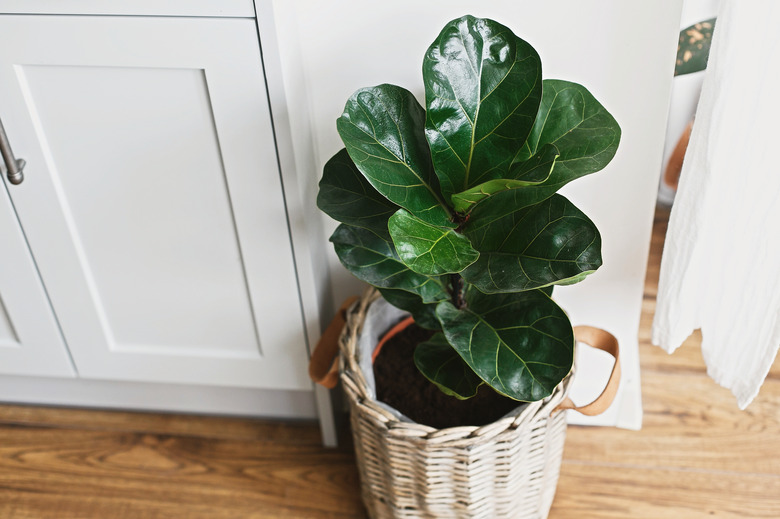How To Care For A Fiddle Leaf Fig
We may receive a commission on purchases made from links.
- Best Uses for Fiddle Leaf Figs
- How to Care for Fiddle Leaf Figs
- Soil, Light and Water Recommendations for Fiddle Leaf Figs
- Fertilizer Recommendations for Fiddle Leaf Figs
- Humidity and Temperature Recommendations for Fiddle Leaf Figs
- How to Prune Fiddle Leaf Figs
- Potting (and Repotting) Fiddle Leaf Figs
- How to Propagate Fiddle Leaf Figs
- Common Pests and Other Problems for Fiddle Leaf Figs
- Common Diseases for Fiddle Leaf Figs
- Toxicity Information About Fiddle Leaf Figs
Aptly named for their large, violin-shaped leaves, fiddle leaf figs (Ficus lyrata, USDA 10-12) are an on-trend plant — popping up in living rooms and Instagram posts everywhere. Large and lush, these plants command attention and look great anywhere. Once you choose a home for your plant, however, it's best to keep it there. Fiddle leaf figs don't take kindly to being moved once they've found a comfortable spot, so make sure you place your fig exactly where you want it.
The fiddle leaf makes an awesome houseplant, but it does require some work. These plants can prove finicky and sometimes plant parents struggle to keep them alive. Although they can be challenging, they don't have to be. The key to success is learning what your fiddle leaf fig needs and then staying diligent about providing it. If you do, you'll have no trouble with your plant and may even earn some bragging rights at the local garden club.
Best Uses for Fiddle Leaf Figs
Best Uses for Fiddle Leaf Figs
Reaching heights of more than 6 feet tall in containers (up to 100 feet in the landscape) and boasting large, shiny leaves, the fiddle leaf fig is anything but subtle. They're an excellent choice if you have a room that needs some color or if you want to bring the outdoors inside in a meaningful way. Like several other houseplants, fiddle leaf figs do a good job of cleaning the air in your home. The larger the plant, the better it performs this task.
How to Care for Fiddle Leaf Figs
How to Care for Fiddle Leaf Figs
- Common Name: Fiddle leaf fig
- Botanical Name: Ficus lyrata
- Sun Exposure: Copious amounts of indirect or filtered light
- Soil Type: Well-drained soil
- Mature Size: 6 feet tall or more
- When it's in Trouble: Drooping leaves, browning leaves
- When it's Thriving: Lush, shiny foliage in a deep-green hue
Soil, Light and Water Recommendations for Fiddle Leaf Figs
Soil, Light and Water Recommendations for Fiddle Leaf Figs
Fiddle leaf figs need copious amounts of sunlight, but they prefer to receive it indirectly. Plants that get direct sunlight will often suffer sunburn. Sitting in front of an east-facing window covered by a sheer curtain is fiddle leaf fig paradise. Wherever you set it, remember to rotate your plant about once a month. If you don't, the plant will start to lean toward the light and become crooked.
As a general rule, the fiddle leaf fig plant needs to be watered once a week. Large plants in small pots may need watering more often, and small plants in big containers may need less water. To check, stick your finger 2 or 3 inches into the soil. If it's dry, water it. If not, wait until it is dry.
When you do water the plant, use room temperature water to avoid shocking the plant with hot or cold water. Water slowly, moving your watering can in a circular pattern around the plant, making sure you wet all the soil.
Plant your fiddle leaf fig in well-drained but nutrient-rich soil. It takes a lot of energy to produce leaves as large as those found on this plant, and nutrient-deficient soil will force the plant to work harder.
Dust will collect on a fiddle leaf fig's supersized leaves, which can block light and make photosynthesis more difficult — so cleaning your plant regularly is an essential when caring for your fiddle leaf fig. Dust the leaves of your plant with a damp cloth about once a month to keep it healthy and looking its best.
Fertilizer Recommendations for Fiddle Leaf Figs
Fertilizer Recommendations for Fiddle Leaf Figs
A fiddle leaf fig can benefit from fertilization, but too much feeding will make the plant leggy and may ultimately kill it. To avoid problems, feed your plant once a month in the spring and summer with a 3-1-2 fertilizer. Don't bother with fertilization in the fall or winter when the plant's growth slows.
Humidity and Temperature Recommendations for Fiddle Leaf Figs
Humidity and Temperature Recommendations for Fiddle Leaf Figs
Remember that the fiddle leaf fig is a tropical plant. It needs temperatures between 65 and 75 degrees Fahrenheit and a humidity level of at least 40 percent. Note that 40 percent is the absolute lowest acceptable humidity level and you should strive for something higher. Mist the leaves of your fiddle leaf fig plant frequently or place it in a room with a humidifier. If you live in a dry climate, ask for recommendations at the plant store.
Your plant will enjoy warm temperatures and high humidity, but the fiddle leaf fig is notoriously fussy about drafts. Do not place it near a drafty window, heating vent or air conditioning unit.
How to Prune Fiddle Leaf Figs
How to Prune Fiddle Leaf Figs
The best time to prune your fiddle leaf fig is in the spring when it will have plenty of time to recover and sprout new growth. When pruning, remove browning leaves as well as any that crisscross each other. Make your cuts at least 1/2 inch away from the trunk of the tree, and always cut at a 45-degree angle.
Never remove more than five to 10 leaves from the plant at a time when pruning, as this can weaken the plant. You may choose to remove leaves from anywhere on the plant to get the shape you want. If you want your fiddle leaf fig to more closely resemble a tree, prune away the bottom leaves.
Note that in its native western Africa, the fiddle leaf fig can easily exceed "ceiling height." If yours is getting a little too tall for your ceiling, you can simply cut the top off the plant. Known as radical pruning, this approach will encourage your plant to sprout new growth while keeping it a manageable size.
Potting (and Repotting) Fiddle Leaf Figs
Potting (and Repotting) Fiddle Leaf Figs
Like all container-grown plants, the fiddle leaf fig will outgrow its current living space. It's time to repot when your plant's roots start to poke out of the bottom of the pot. Typically, this occurs about once every two years. You have two options at repotting time.
The first is to move your plant to a larger container. If you want the plant to keep growing larger, this is the option you'll choose. Select a new container that is 2 to 4 inches larger than the old pot. Use good-quality, fresh potting soil. Gently work your fiddle leaf fig out of its old pot and place it in the new pot, filling the pot with soil until it sits about an inch below the top of the pot.
Perhaps your fiddle leaf fig is tall enough and you wish to keep it at its current size. In this case, you will gently work the plant out of its container and trim the root ball. Trim the longer roots so that your plant will better fit in the same pot. Don't remove more than 20 percent of the root ball, however, or you may damage it.
Dispose of the old potting soil and fill the old pot with a layer of fresh soil. Then, place the fiddle leaf fig back in its original pot and replant it there, again filling the pot with fresh soil until it is about 1 inch below the rim of the container. Whatever method you choose, water your plant thoroughly after repotting.
How to Propagate Fiddle Leaf Figs
How to Propagate Fiddle Leaf Figs
If you love your fiddle leaf fig and want to make more, you can propagate your plant with relative ease. First, choose a branch that contains a few healthy leaves. Cut it off the plant at the node, just above the place where the leaf meets the tree.
Place the cut branch in a jar of filtered water and place it in a sunny spot. Change the water when it gets too low or starts to appear cloudy. In about a month, your cutting will sprout roots. When they're a few inches long, remove your leaf from the water and plant it in a small container. It's as simple as that.
Common Pests and Other Problems for Fiddle Leaf Figs
Common Pests and Other Problems for Fiddle Leaf Figs
Fiddle leaf figs aren't especially prone to pest problems, but they can experience mealybugs, spider mites, aphids and scales. Fortunately, these are easy to control in an indoor environment. These pests typically hang out on the underside of the plant's large leaves, so take a look for them every once in a while. If you see them, simply wash them off the plant with a rag soaked in hot, soapy water.
Pests generally aren't an issue, but water can be. Some people overwater their fiddle leaf figs, which causes brown edges to form on the leaves. If you're underwatering the plant, brown spots are likely to appear all over the leaves. If you see these problems, adjust your watering schedule accordingly.
Common Diseases for Fiddle Leaf Figs
Common Diseases for Fiddle Leaf Figs
It's quite rare for a fiddle leaf fig to develop a disease. Typically, any leaf discoloration you see on a fiddle leaf fig is the result of improper watering or lighting. Although rare, these plants can develop rot.
If rot is an issue, begin treating it by removing any damaged or discolored leaves from the plant. You can then remove it from the pot and examine the roots. You should see white, firm roots. If you see any brown or mushy ones, cut them off the plant. Remove as much of the old potting soil as you can from the root ball and repot the fiddle leaf fig in fresh, clean potting soil.
To prevent the rot from returning, water your plant only when the top 3 inches of soil dry out. Root rot is typically caused by overwatering, which you can easily correct. It may take a few months for your plant to fully recover from an episode of rot, however, so be patient.
Toxicity Information About Fiddle Leaf Figs
Toxicity Information About Fiddle Leaf Figs
The fiddle leaf fig is toxic to small children, cats and dogs if ingested. Although not considered deadly, eating the plant can cause stomach irritation, nausea, vomiting and drooling. As such, it's best to keep your plant where children and pets won't have easy access to it.
If you do suspect that someone has ingested part of your plant, a trip to the doctor or veterinarian is in order. A doctor can best assess the severity of the toxicity and help relieve any symptoms and discomfort.


